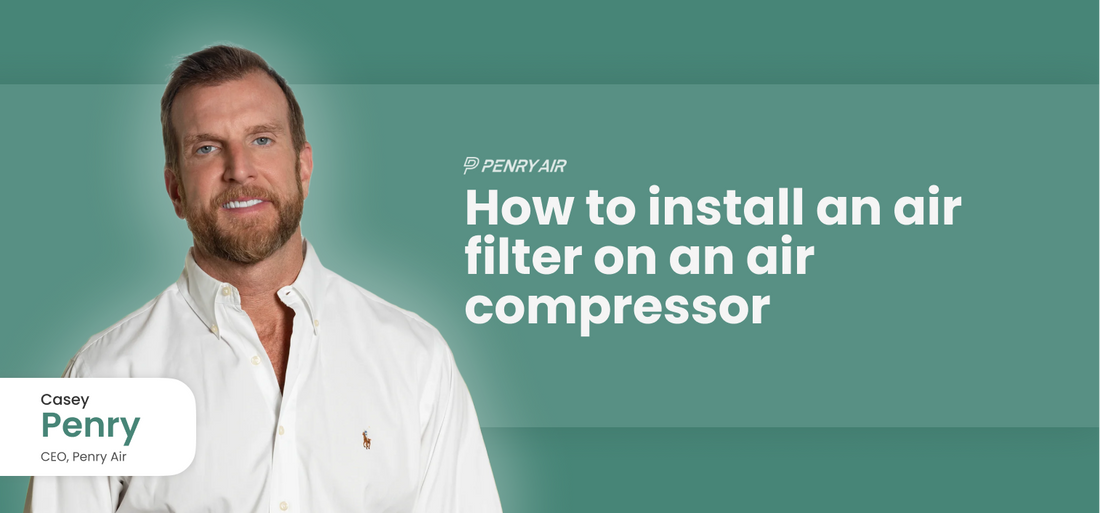How To Install An Air Filter On An Air Compressor

Compressed air is one of the most expensive utilities in any facility. Without proper filtration, contaminants like dust, oil mist, and moisture can damage tools, clog piping, and reduce efficiency. The right air filter keeps your system running smoothly, improves air quality, and even lowers energy costs.
As a compressed air specialist, I can tell you that installing and maintaining filters isn’t complicated. With the right approach, you can protect your equipment and extend the life of your system.
Why Air Filters Matter in Compressed Air Systems
Compressed air isn’t naturally clean. It often carries:
-
Particulates (dust, dirt, rust from pipes)
-
Oil aerosols (from lubricated compressors)
-
Moisture (condensation inside the air lines)
If left unchecked, these contaminants lead to:
-
Tool and equipment breakdown
-
Higher maintenance costs
-
Bacterial growth in piping
-
Increased pressure drop → higher energy bills
The right filter eliminates these risks and keeps your operations efficient.
How to Find the Right Filter
There are several ways to identify the best filter for your system:
1. Ask a Specialist
If your system was installed by a technician or distributor, ask them what filter types and micron ratings you need. Common options include:
-
Particulate filters – trap dust and solid particles
-
Coalescing filters – remove oil and water aerosols
-
Activated carbon filters – eliminate odors and vapors
2. Check the System Specs
Most compressors and filter housings list the compatible filter element part numbers. Always follow the manufacturer’s guidelines instead of guessing.
3. Use the Current Filter as a Reference
If you’re replacing a filter, remove the old element and note any part numbers or specifications on the casing. You can also take a photo and show it to your supplier to ensure you get the right match.
4. Consider Micron Ratings & ISO Standards
Unlike HVAC filters that use MERV ratings, compressed air filters are classified by micron size (e.g., 1 μm, 0.01 μm) and ISO 8573-1 air quality standards.
-
General shop air: 1–5 μm filters work well
-
Paint/food/medical use: 0.01 μm + activated carbon may be required
How to Install an Air Filter on an Air Compressor
Here’s a step-by-step process that works for most compressed air systems:
Step 1: Shut Down and Depressurize
Always turn off the compressor and release air pressure before opening any filter housing. This prevents accidents and protects the equipment.
Step 2: Locate the Filter Housing
Filters are usually installed on the compressor outlet, in-line with the piping system, or near the point of use (before tools or machinery).
Step 3: Remove the Old Filter Element
Open the filter bowl or housing, carefully pull out the old element, and dispose of it. If it’s clogged with oil or dirt, you’ll see why replacement is critical.
Step 4: Clean the Housing
Wipe down the inside of the bowl and check seals or O-rings. A clean housing prevents leaks and keeps the new filter performing properly.
Step 5: Install the New Filter Element
Insert the new element, making sure it’s seated correctly. Double-check flow direction arrows on the housing if applicable.
Step 6: Reassemble and Pressurize
Close the housing, restart the compressor, and slowly repressurize the system. Listen for leaks and check that airflow is steady.
Step 7: Record the Installation Date
Log the date so you know when the next replacement is due. Most filters should be changed every 6–12 months, depending on operating conditions.
What If the Filter Doesn’t Fit?
If the new filter doesn’t fit properly, double-check the part number, size, and housing compatibility. Don’t force it — reinstall the old element temporarily and confirm specs with your supplier.
Final Thoughts
Installing and maintaining the right filter in your compressed air system is simple but vital. With clean, dry air, you’ll:
-
Protect tools and machinery
-
Avoid costly downtime
-
Improve system efficiency
-
Lower your energy bills
If you’re not sure which filter your system needs, contact a compressed air specialist or your local Chicago Pneumatic distributor. They’ll help you choose the right solution and even perform a free air audit to uncover savings.